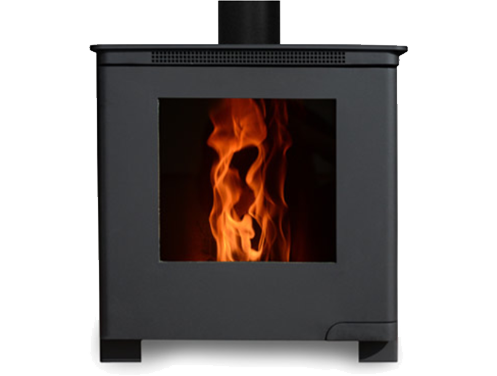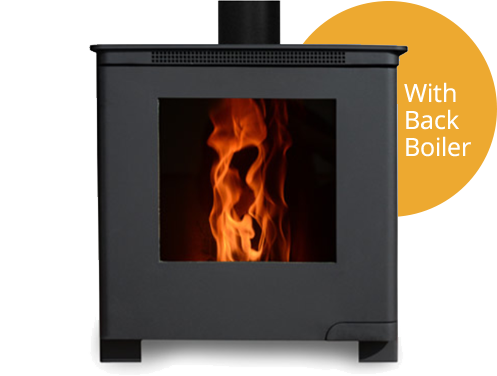Wood Burning Stoves vs Wood Pellet Stoves, which should I choose?
At Island Pellet Stoves, we understand the importance of making informed decisions when it comes to heating your home. If you’re interested in having a wood burning stove installed, you may be struggling to choose between traditional wood burning stoves and modern wood pellet stoves, both of which offer unique benefits.
To help you decide which solution is best for your home, family and lifestyle, below we have compared these two heating methods, highlighting their appeal and considerations.
What are Wood Pellet Stoves?
Wood pellet stoves are modern heating solutions that use compressed wood pellets instead of traditional wood logs as fuel. The pellets are automatically fed into the burn chamber from an onboard storage hopper, enabling consistent and controlled combustion. These contemporary stoves come equipped with electronic components for easy regulation of heat output too and other features that add to user convenience.
What are Wood Burning Stoves?
Wood burning stoves, often referred to as log burners or wood burners, are traditional heating solutions that use logs as fuel. They rely on the manual loading of wood and manual adjustment to the airflow for combustion. These stoves provide an authentic experience, delivering warmth and ambience to a living space.
Comparing These Two Stove Options
There are a few key factors to consider when choosing between these two types of wood burner stoves, including the following-
Efficiency
Wood Pellet Stove
These stoves boast an impressive efficiency rating and the Lundy 8 model has a high efficiency of up to 93%. The biomass pellets are densely packed for longer-lasting heat and almost all of the material is burnt. With connectivity available for an integrated back boiler, our wood pellet stoves can also handle your central heating, underfloor heating and hot water needs.
Traditional Wood Burning Stove
While they offer a rustic charm, the efficiency of traditional wood burning stoves is typically somewhere between 60-70%. This means that a larger proportion of the fuel doesn’t get converted into heat and you may require more wood to keep your home at a comfortable temperature all year round.
Flue Technology
Wood Pellet Stoves
Modern wood pellet stoves benefit from “balanced flue” technology. This advanced system allows for more versatile installation options and makes otherwise impossible jobs feasible, such as horizontal terminals, airtight houses or unconventional layouts. This technology provides an efficiency gain of up to 10% too, resulting in both energy savings and improved performance.
Traditional Wood Burning Stove
Often, traditional stoves require chimneys and they don’t benefit from modern flue technology. This can limit installation options and they aren’t as flexible as pellet stoves. Conventional flue systems may not be suitable for some modern architectural designs and it can be harder to find a solution to carry the stove’s fumes outside.
Emissions and Environment
Wood Pellet Stoves
Pellets burn much cleaner than logs and they are often carbon neutral. They produce very low emissions, exceeding the Ecodesign Standards, which means better air quality and less buildup in the flue. Additionally, wood pellets are often made from waste wood, contributing to their environmentally-friendly status.
Traditional Wood Burning Stoves
Burning logs produces more smoke and particulates, which can contribute to air pollution. However, sourcing sustainably harvested wood can mitigate some of the environmental concerns relating to wood burning stoves. Wood burning stoves have come a long way over the years too and they release less CO2 than they used to.
Fuel Storage and Handling
Wood Pellet Stoves
Pellets come in compact bags and are easy to store, requiring less space. Loading a pellet stove is generally straightforward too and since they’re fully automatic, once the hopper is full it will feed pellets to the stove, so you won’t have to open the doors to refuel for many hours.
Traditional Wood Burning Stoves
Logs take up more storage space and can be quite messy. You will also have to manually load logs into the wood burner stove, which might need to be done frequently depending on factors like the stove’s size and the wood’s dryness.
Convenience
Wood Pellet Stoves
Following on from the above, wood pellet stoves are much more convenient to use. With features like timers, thermostat control and automatic ignition, these stoves provide a seamless heating experience. You can set the desired temperature and the stove takes care of the rest without the need for continuous monitoring or manual adjustments.
Traditional Wood Burning Stoves
Log burners require a more hands-on approach to heating. Without the modern conveniences of timers or thermostats, you will need to manually control the airflow and feed the fire. To ensure your home remains comfortable, it’s important to keep an eye on the temperature.
Up-front and Running Costs
Wood Pellet Stoves
While the initial investment in a modern wood pellet stove might be higher and electricity is key to feed the stove, the cost of pellets can be lower than logs, especially if sourced locally. The higher efficiency of this type of stove also means potentially lower heating bills.
Traditional Wood Burning Stoves
The cost of buying a traditional stove can be lower and it doesn’t require electricity to operate. However, depending on where you live, the cost of firewood can quickly add up. This is especially true if you’re sourcing seasoned, high-quality wood that’s also sustainable.
Aesthetics and Experience
Wood Pellet Stoves
Modern pellet stove designs perfectly complement contemporary homes. They offer the beauty of a real wood flame without the downsides associated with traditional log burners. Our stoves are manufactured to fit into conventional fireplaces or existing alcoves and they are a stylish solution. It’s worth noting that wood pellet stoves are also silent whilst running.
Traditional Wood Burning Stoves
For many homeowners, the charm of a classic wood burning stove is what makes them so popular. The scent, sound and sight of crackling logs can create a cosy ambience. If you don’t take good care of your traditional stove, it can quickly start to look messy and dirty though, so you need to stay on top of regular cleaning.
Maintenance
Wood Pellet Stoves
These stoves have some mechanical parts like motors and ignitors which may require maintenance, yet they are designed for long life. With reduced ash buildup and a simple cleaning system, it’s easy to remove ash from the grate though and you won’t need chimney sweeps. Generally, the tubes only need to be cleaned a few times a year too.
Traditional Wood Burning Stoves
Classic wood burning stoves have fewer moving parts, making them durable. However, they may require more regular chimney cleaning due to increased soot and residue. The system should also be inspected annually to ensure its safety. As mentioned above, you need to clean them quite frequently to keep them looking their best too.
Which Solution is Best?
Now you know a little bit more about both traditional wood burning stoves and wood pellet stoves, you should find it easier to decide which option is best suited to your home. Should you have any questions about installing a stove, get in touch with our team at Island Pellet Stoves today. We will happily provide you with any additional information and the expert opinions you need to ensure you’re investing in the right stove for your living space.
All of our stoves are HETAS and Defra approved, UK Patented, and we are winners of the 2017 Hearth and Home award. Learn more about our accreditations here.
View our Pellet Stove Products
We have a convection room heat only stove which heats the space in which it is installed and we have a boiler version which can connect to a hot water tank, radiators in other rooms or even a buffer vessel. We have some real novel options such as what we call a ‘balanced flue’ which means the air supply is drawn from the top of the chimney and this means a lower height flue can be used. Take a look at our products but always remember you are welcome to get in touch with any questions.






